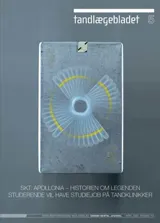Usædvanlige komplikationer til implantatbehandling: blødning, emboli, migration – en litteraturoversigt
Implantatbehandling i mundhulen er i dag en rutinemæssig behandling, som har en høj succesrate og kun sjældent medfører komplikationer. Undtagelsesvis kan dog opstå usædvanlige og undertiden alvorlige komplikationer, og på baggrund af litteraturen gennemgås i nærværende artikel tre former for heldigvis sjældne komplikationer. De omfatter 1) større arterielle blødninger, 2) luftemboli og 3) migration af implantater. Større arterielle blødninger, som næsten udelukkende optræder i mundbunden, kan medføre blokering af luftvejene og dermed være livstruende. Venøs luftemboli er også en yderst farlig tilstand, og der er eksempler på opståen i forbindelse med implantatbehandling. Migration af implantater til overkæbens bihuler er ikke farlig, men kræver operativ indgriben.
Unusual complications to oral implant treatment: severe haemorrhage, embolism, implant-migration: In implant treatment a number of complications may occur. This paper deals with three unusual complications, severe haemorrhage, air embolism, and migration of implants. Severe and life-threatening haemorrhage may occur during and after implant procedures in the mandible, especially the ante- rior, interforaminal region. Three arteries, the sublingual artery, the submental artery, and the mylohyoid branch of the inferior alveolar artery, are in close proximity to the lingual surface of the mandible and may be traumatized. Artery lesions may also occur where branches of the arteries enter the bone through the lingual foramen and accessory lingual foramina. Emergency treatments (intubation, tracheotomy/coniotomy and ligation of arteries) in dental practice as well as preventive precautions are summarized. Air embolism is a dangerous complication which may result from injection of air into the venous system follow ing use of handpieces driven by compressed air during surgical implant procedures. Migration of implants into the maxillary sinus and even further are sometimes seen. The condition is without danger, but surgical removal is necessary.


